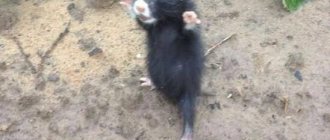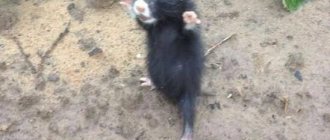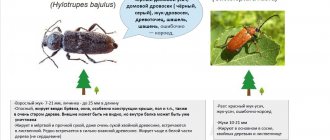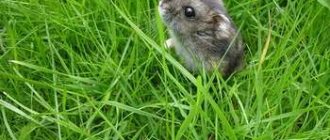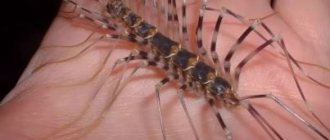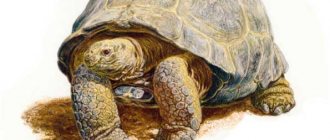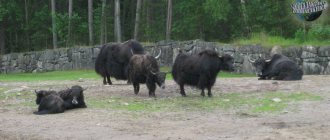The common hamster (Cricetus) is one of the largest rodents in the hamster family (Cricetidae) and one of the most endangered mammals in Western and Central Europe. The common hamster is also called the "Eurasian hamster", "Black-bellied hamster" or "European hamster", and is the only species in the genus Cricetus. It is native to many countries in Eurasia, from Belgium to the Altai highlands and the Yenisei riverside in Russia. Where the hamster population is large, the rodent is considered an agricultural pest and is also killed for its valuable fur. In some Western European countries, the common hamster is endangered.
European hamsters inhabit low-lying agricultural land with soft loam or loess soils, although they can also be found in meadows, gardens or hedgerows.
What does a wild hamster look like?
It has some similarities with the domestic hamster, but differs from it in size. An adult male reaches a length of 37–39 cm and weighs up to 700 grams. The female is slightly smaller, but also quite impressive.
The field hamster has a rounded body, practically devoid of a neck, so the transition from head to body is imperceptible. The tail is 3–8 cm long, thick near the base and tapering to the tip.
Photo of a field hamster
The muzzle is of medium length with a stiff mustache and black shiny eyes. The ears are small, round, covered with dark hairs.
The teeth of a wild hamster are very long and sharp. During life they are constantly worn down and renewed.
The legs are short and strong, sometimes it seems that the hamster is crawling on the ground. The common hamster has well-developed feet and toes with long and hard claws, which are adapted for digging holes and holes.
The body of the karbysh is covered with dense soft wool with undercoat. The color of the animal is varied. There are specimens that are reddish-brown or yellow in color with a dark undercoat. There is a black and white pattern on the surface of the body.
Usually the abdomen is black in color. There are light spots on the sides, which are separated by black lines. Light spots may be present on the sides of the head, in the area of the shoulder blades and behind the ears.
Photo of a wild hamster
Very rarely in the wild there are individuals with black coloring, in which white spots are located only on the throat and paws.
The lifespan of a rodent in the wild is 4 years.
Pet cage
Before you get a rodent, you need to purchase a cage made of metal rods for it. Its minimum size is 25 by 30 cm.
It is advisable that the metal grilles are not painted.
The rodent can taste the cage. The paint that covers the bars in the cage can cause allergies or poisoning to a small pet.
The distance between the rods should be no more than 1 cm. The door should close tightly. It is advisable to have a pull-out tray with small sides.
This will make caring for the animal easier.
The filler will not spill out of the cage if the hamster decides to frolic.
The cage can be one- or two-level.
A tunnel or small staircase is installed between the floors.
Living conditions
The wild hamster is widely distributed from southern and central Europe to northwestern China. It prefers forest-steppes, steppes and mixed-grass meadows. Currently, the rodent's habitat has expanded somewhat. This is due to massive deforestation.
The hamster is not afraid of human proximity, so it willingly explores the territories of personal plots, fields, orchards, and vegetable gardens. If there is not enough food, it can settle in a living room.
The field hamster is not afraid of harsh winters or cold climates. He takes refuge in his hole. The karbysh’s home has an interesting structure. It consists of several rooms and nests. The length of a wild hamster's burrow can reach 8 meters wide and 1.5 meters deep. It has up to 10 outputs, several of which are false.
Photo of a common hamster in nature
Animals are most active in the evening and at night. During the day they hide in a hole.
Rodents do not have a good disposition and show aggression towards everyone, even humans. Males are only friendly to females during the breeding season.
Hamsters are solitary animals and protect their territory. They can attack an intruder, regardless of its size.
Owner reviews
Few people get this particular breed of hamster. But still, some acquire such a favorite for themselves. Owners of hamsters say that the animals are not picky about care, maintenance and nutrition. If we talk about the character of rodents, then each, of course, has its own character.
They are mostly quite active at night. During the day, as the owners say, they often sleep. The owners note that such animals are extremely shy. Therefore, you need to treat them with care. Since a frightened animal can even bite its owner. As the owners say, the injury will be minor, but still unpleasant.
What does it eat in nature?
The rodent is omnivorous. He has a good appetite. The main diet consists of plant foods, but in spring and summer it will not refuse insect larvae, small reptiles, crustaceans and mollusks.
With the onset of autumn, the animal consumes more plant foods. At this time, the hamster's harvesting season begins. The field hamster's diet is based on corn, peas, grains of wheat, buckwheat, millet, potatoes and carrots, the reserves of which he stores in pantries.
Wild hamster - carbysh
The rodent creates supplies thanks to its cheek pouches, which it uses to carry food. One bag holds up to 50 g of grain, which the animal can carry over a distance of more than a kilometer, supporting the bags with its front paws.
Wild hamsters store large amounts of food in their burrow. Burrows with huge reserves were discovered, hundreds of times exceeding the rodent's own weight.
Karbysh eat food while sitting on its hind legs. He eats by holding the food with his front paws and stuffing the food into one cheek, then the other, then quickly chews it.
Conservation status
Until 1960, the soft-haired animal was the object of the fur trade in Czechoslovakia, Germany and the USSR. A sharp decline in numbers forced the cessation of fur harvesting in the middle of the 20th century. Western European countries have approved national programs to ensure the conservation of this species.
These include Belgium, the Netherlands, Germany, Poland, France, Belarus and Ukraine. It is also protected in five constituent entities of the Russian Federation.
The number of animals is unchanged in Siberia and Kazakhstan, and the number of animals in the Krasnodar Territory and Azov District of the Rostov Region causes significant damage to agriculture. Although the total number of the species continues to decrease.
Did you know? Smart hamsters can remember their name and perform some tricks.
Reproduction
The breeding season for wild hamsters begins in April and lasts until the end of October.
The female reaches sexual maturity at 3 months. The gestation period is 16 days, so during the summer she manages to bear offspring 2–3 times.
Males show interest in females only during mating, after which they immediately leave her. Often one rodent creates families with several females. The male does not take any part in caring for the offspring.
The average number of cubs is 10 – 18. Babies are born blind and naked. Newborns weigh only 4–6 grams. The cubs develop very quickly. At the age of two weeks, hamsters open their eyes and become covered with fur.
Common field hamster
The feeding period is 20 days, but after 7–10 days the cubs are able to eat solid food. The mother closely monitors the offspring and, in case of danger, moves the cubs to a safe place.
In the wild, rodents are unable to protect themselves from attacks by predators. Natural enemies make it possible to control the population of these animals. Birds of prey, wolves, lynxes, and foxes pose a threat to the field hamster. They may be attacked by cats and dogs in the garden area.
Notes
- Sokolov V. E.
Five-language dictionary of animal names. Mammals. Latin, Russian, English, German, French. / under the general editorship of academician. V. E. Sokolova. - M.: Rus. lang., 1984. - P. 156. - 10,000 copies. - [genomics.senescence.info/species/entry.php?species=Cricetus_cricetus Black-bellied hamster (Cricetus cricetus) longevity, aging, and life history]. Retrieved January 3, 2013. [www.webcitation.org/6Do9jpKM0 Archived from the original on January 20, 2013].
Difference between wild and domestic hamster
Wild hamsters differ from tame pets not only in size and appearance. Rodents are quite aggressive and pose a danger to humans, and once settled in a garden or vegetable garden, they can threaten future harvests.
Unlike wild hamsters, domestic animals have a calmer and more docile character and are easily tamed.
Wild hamster eats blackberries
The common field hamster cannot be tamed, so it is much easier and safer to purchase a pet hamster.
It is not advisable to purchase several rodents, since rodents of different sexes will constantly produce offspring, and rodents of the same sex will fight.
To buy or not to buy?
The first thing you need to pay attention to is that family members are not allergic to animal hair or bedding fillers. Second, but no less important, is the choice of location for the cage of the future pet. Hamsters equally do not like drafts, too warm or cold air, and dampness. They do not belong in a smoky room, on the floor or windowsill. It is important to remember that these are living beings and they have the right to demand that they be treated with dignity.
flickr/pyza
Other indisputable advantages of keeping hamsters include their low cost and ease of care, which does not require special skills. The small amount of food a hamster needs for a full life will not affect the family budget in any way, and its cage will not take up much space in the apartment.
Why did wild hamsters appear in the country? How to get rid of it?
With the onset of summer, wild hamsters often take up residence in gardens and vegetable gardens. This is due to the ripening of the crop and the beginning of the harvesting season for animals.
Rodents cause enormous harm to homestead farms. The large number of wild hamsters and the ability to adapt to any conditions allows them to quickly develop territory, and the ability to build complex burrows makes them difficult to destroy.
The presence of a hamster in the garden can be guessed by the following signs:
- tunnels and exits from holes. In the hamster they are wider than in moles and shrews;
- damaged bark in the lower part of fruit trees, since animals like to gnaw the bark at the very bottom, near the roots;
- digging in carrot beds and near potato bushes;
- the presence of characteristic small marks.
Common hamster
Currently, farmers and summer residents use different ways to deal with uninvited guests.
- Flooding holes. To do this, close all exits from the hole and pour water until the hamster crawls out. If not all emergency passages are closed, the animal can get out and run away.
- Digging holes and catching by hand. Very labor-intensive and dangerous.
- Use of traps and snares. The devices are effective, but it is very difficult to track where to install them
- Poisoned baits. Rat and mouse poisons are most often used. The disadvantage of use is the destruction of a small number of pests. Domestic cats and dogs may also be affected.
- Use of noise and ultrasonic repellers. Quite a costly method. Also, protecting a large area will require a significant number of devices.
Distribution area
The common hamster, also called the field hamster, lives on the Eurasian continent, mainly in the steppe and forest-steppe zones.
In the south of Europe, the natural border of distribution of this species of mammals is the coast of the Azov and Black Seas, in Asia - deserts and semi-deserts, the foothills of the Tien Shan and Altai. The common hamster is not found north of the Yaroslavl and Kirov regions in the European part of Russia, or the Yekaterinburg - Tobolsk - Krasnoyarsk line in Western Siberia.
Be sure to read:
Eye diseases in a hamster: symptoms, diagnosis, treatment
The rodent chooses to live in the outskirts of fields, river valleys (not swampy ones), gardens and park areas. It settles near people, for example, in dachas. But most of all, steppes with an abundance of grasses and cereals suit him.
What to do if bitten by a wild hamster?
The bite of a field hamster is very dangerous for both humans and domestic animals. The animal's teeth are very sharp and long, and when they bite, they leave deep wounds with ragged edges. In addition, fleas living on the body of a rodent are carriers of infectious diseases.
If a rodent does bite, you should immediately wash the wound with warm running water and soap and treat it with a disinfectant. To do this, you can use alcohol, hydrogen peroxide, iodine, brilliant green.
Swelling and redness may appear at the site of the bite. In severe cases, the temperature rises, general weakness and difficulty breathing occur. To prevent unpleasant consequences, you should seek emergency medical help, which includes a course of injections for tetanus and rabies.
